中国建筑文化(英文)
- 格式:ppt
- 大小:5.72 MB
- 文档页数:24
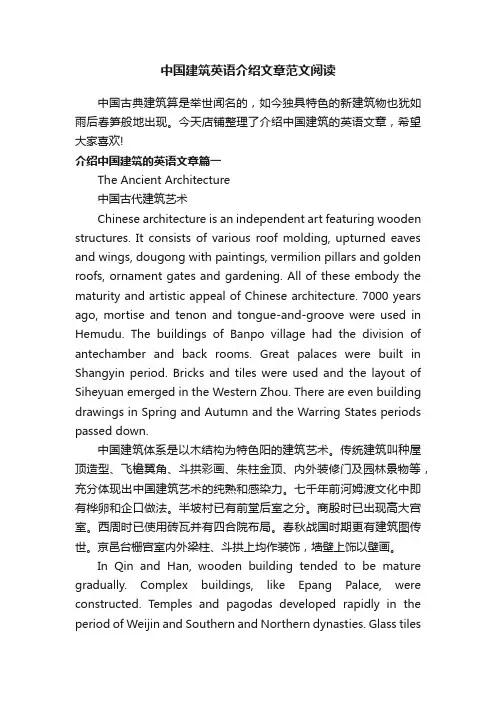
中国建筑英语介绍文章范文阅读中国古典建筑算是举世闻名的,如今独具特色的新建筑物也犹如雨后春笋般地出现。
今天店铺整理了介绍中国建筑的英语文章,希望大家喜欢!介绍中国建筑的英语文章篇一The Ancient Architecture中国古代建筑艺术Chinese architecture is an independent art featuring wooden structures. It consists of various roof molding, upturned eaves and wings, dougong with paintings, vermilion pillars and golden roofs, ornament gates and gardening. All of these embody the maturity and artistic appeal of Chinese architecture. 7000 years ago, mortise and tenon and tongue-and-groove were used in Hemudu. The buildings of Banpo village had the division of antechamber and back rooms. Great palaces were built in Shangyin period. Bricks and tiles were used and the layout of Siheyuan emerged in the Western Zhou. There are even building drawings in Spring and Autumn and the Warring States periods passed down.中国建筑体系是以木结构为特色阳的建筑艺术。
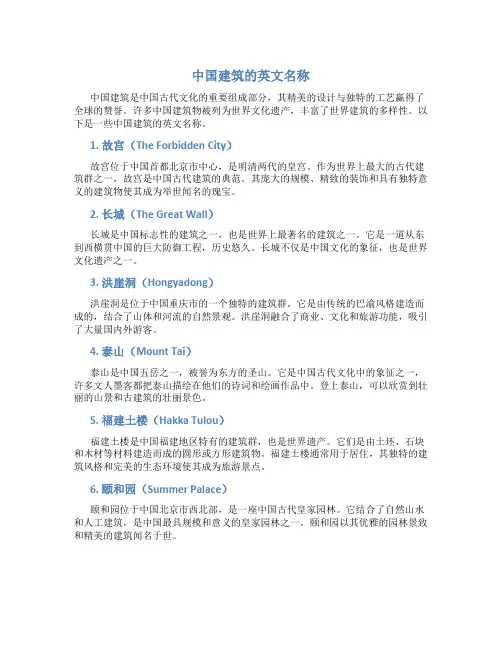
中国建筑的英文名称中国建筑是中国古代文化的重要组成部分,其精美的设计与独特的工艺赢得了全球的赞誉。
许多中国建筑物被列为世界文化遗产,丰富了世界建筑的多样性。
以下是一些中国建筑的英文名称。
1. 故宫(The Forbidden City)故宫位于中国首都北京市中心,是明清两代的皇宫。
作为世界上最大的古代建筑群之一,故宫是中国古代建筑的典范。
其庞大的规模、精致的装饰和具有独特意义的建筑物使其成为举世闻名的瑰宝。
2. 长城(The Great Wall)长城是中国标志性的建筑之一,也是世界上最著名的建筑之一。
它是一道从东到西横贯中国的巨大防御工程,历史悠久。
长城不仅是中国文化的象征,也是世界文化遗产之一。
3. 洪崖洞(Hongyadong)洪崖洞是位于中国重庆市的一个独特的建筑群。
它是由传统的巴渝风格建造而成的,结合了山体和河流的自然景观。
洪崖洞融合了商业、文化和旅游功能,吸引了大量国内外游客。
4. 泰山(Mount Tai)泰山是中国五岳之一,被誉为东方的圣山。
它是中国古代文化中的象征之一,许多文人墨客都把泰山描绘在他们的诗词和绘画作品中。
登上泰山,可以欣赏到壮丽的山景和古建筑的壮丽景色。
5. 福建土楼(Hakka Tulou)福建土楼是中国福建地区特有的建筑群,也是世界遗产。
它们是由土坯、石块和木材等材料建造而成的圆形或方形建筑物。
福建土楼通常用于居住,其独特的建筑风格和完美的生态环境使其成为旅游景点。
6. 颐和园(Summer Palace)颐和园位于中国北京市西北部,是一座中国古代皇家园林。
它结合了自然山水和人工建筑,是中国最具规模和意义的皇家园林之一。
颐和园以其优雅的园林景致和精美的建筑闻名于世。
7. 华山(Mount Hua)华山是中国五岳之一,位于陕西省。
它以险峻的山峰而闻名于世,也是中国著名的登山胜地。
华山以其壮丽的自然景观和古代道教建筑而吸引了众多游客。
8. 潍坊国际风筝博物馆(Weifang International Kite Museum)潍坊国际风筝博物馆是中国山东省潍坊市的一座特色博物馆。
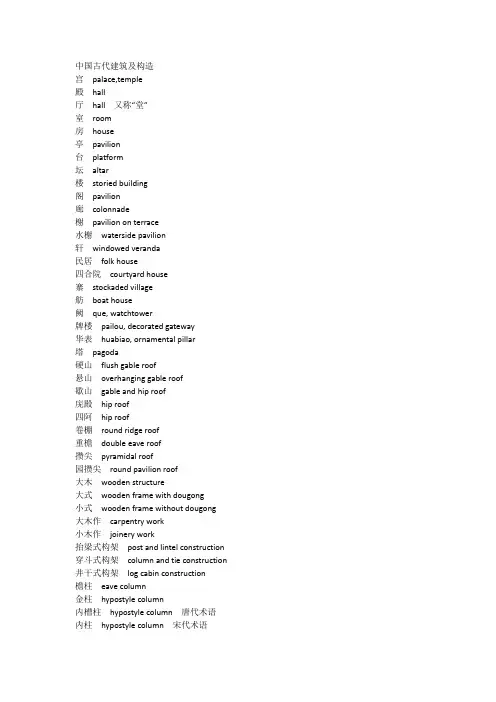
中国古代建筑及构造宫palace,temple殿hall厅hall又称“堂”室room房house亭pavilion台platform坛altar楼storied building阁pavilion廊colonnade榭pavilion on terrace水榭waterside pavilion轩windowed veranda民居folk house四合院courtyard house寨stockaded village舫boat house阙que, watchtower牌楼pailou, decorated gateway华表huabiao, ornamental pillar塔pagoda硬山flush gable roof悬山overhanging gable roof歇山gable and hip roof庑殿hip roof四阿hip roof卷棚round ridge roof重檐double eave roof攒尖pyramidal roof园攒尖round pavilion roof大木wooden structure大式wooden frame with dougong小式wooden frame without dougong大木作carpentry work小木作joinery work抬梁式构架post and lintel construction 穿斗式构架column and tie construction 井干式构架log cabin construction檐柱eave column金柱hypostyle column内槽柱hypostyle column唐代术语内柱hypostyle column宋代术语山柱center column角柱corner column唐、宋术语瓜柱short column脊瓜柱king post蜀柱king post宋代术语雷公柱suspended column帐杆suspended column宋代术语侧脚cejiao宋代术语卷杀entasis梭柱shuttle-shaped column宋代术语角背bracket由戗inverted V-shaped brace叉手chashou, inverted V-shaped brace宋代术语柁墩wooden pier驼峰tuofeng, camel-hump shaped suport宋代术语梁beam袱beam宋代术语月梁crescent beam三架梁3-purlin beam平梁3-purlin beam宋代术语四架梁4-purlin beam五架梁5-purlin beam四椽袱5-purlin beam宋代术语六架梁6-purlin beam七架梁7-purlin beam六椽袱7-purlin beam宋代术语九架梁9-purlin beam八椽袱9-purlin beam宋代术语单步梁one-step cross beam双步梁two-step cross beam挑尖梁main aisle exposed tiebeam乳袱rufu, beam tie宋代术语抱头梁baotou beam穿插枋penetrating tie角梁hip rafer桁purlin (used with dougong)大式檩purlin (used without dougong)小式抟purlin宋代术语脊桁ridged purlin大式脊檩ridged purlin小式脊抟ridged purlin宋代术语金桁intermediate purlin大式金檩intermediate purlin小式上中平抟intermediate purlin宋代术语老檐桁purlin on hypostyle大、小式,宋代术语正心桁eave purlin大式檐檩eave purlin小式下平抟eave purlin宋代术语额枋architrave(used with dougong)大式檐枋architrave(used with dougong)小式阑额architrave宋代术语由额垫板cushion board大式檐垫板cushion board小式枋tiebeam脊枋ridge tiebeam上金枋upper purlin tiebeam下金枋lower purlin tiebeam老檐枋eave tiebeam大式,指檐口构造檐枋eave tiebeam小式,指檐口构造顶椽top rafter脑椽upper rafter花架椽intermediate rafter檐椽eave rafter飞檐椽flying rafter飞子flying rafter宋代术语连檐eave edging瓦口tile edging颔版tile edging宋代术语举架raising the purlin举析raising the purlin宋代术语步架horizontal spacing between purlins材cai栔qi分fen斗口doukou,mortise of cap block斗拱dougong,bracket set斗dou, bracket set升block with cross mortise大斗cap block栌斗cap block宋代术语拱gong,bracketarm翘flower arm, petal华拱flower arm宋代术语昂ang,lever槽升子center block齐心斗center block宋代术语三才升small block十八斗connection block交互斗connection block宋代术语正心拱axial bracket arm泥道拱axial bracket arm宋代术语瓜拱oval arm瓜子拱oval arm宋代术语万拱long arm慢拱long arm宋代术语厢拱regular arm令拱regular arm宋代术语单材拱outer-side bracket arm撑头small tie-beam枋small tie-beam宋代术语耍头nose攒set of bracket柱头科bracket set on columns柱头铺作bracket set on columns宋代术语平身科bracket sets between columns补间铺作bracket sets between columns宋代术语角科bracket set on corner转角铺作bracket set on corner宋代术语出extension of bracket出跳extension of bracket宋代术语cai跳tiao宋代术语雀替sparrow brace搏缝板gable eave board搏缝版gable eave board宋代术语木装修joiner's work外檐装修exterior finish work内檐装修interior finish work框槛door frame槛stud抱框jamb on door or window格栅partition door抹头window stool棂子grill裙板panel槛窗sill wall window榻板window sill支摘窗removable window门枕door bearing门簪decorative cylinder门跋door knocker门钉decorative nails on door leaf门枕石bearing stone抱鼓石drum-shaped bearing stone天花ceiling帽儿梁lattice framing支条lattice framing井口天花compartment ceiling海墁天花flat ceiling藻井caisson ceiling罩shelf龛niche博古架antique shelf瓦石作masonry檐墙eave wall廊墙partition wall扇面墙horizontal partition wall隔断墙vertical partition wall槛墙sill wall樨头gable wall head挑檐石cantilever stone on eave五花山墙stepped gable wall拔磉corbel, hanging over叠涩corbel, hanging over宋代术语角柱石corner pier阶条石rectangular stone slab压阑石rectangular stone slab宋代术语台阶steps踏道steps宋代术语踏垛step踏step宋代术语斗板石intermediate pier垂带drooping belt stone副子drooping belt stone宋代术语象眼triangular space御路yulu, imperial path羌差ramp须弥座xumizuo圭角guijiao上枋upper fillet and fascia下枋lower fillet and fascia上袅upper cyma, recta下袅lower cyma, reversa束腰suyao钩栏balustrade宋代术语单钩栏single frieze balustrade宋代术语垂台钩栏double frieze balustrade望柱baluster望柱头baluster capital栏版frieze panel华版frieze panel地伏plinth stone寻杖handrail宋代术语柱顶石capital stone柱础column base踬zhi碑碣stone tablet赑屃bixi, stone turtle宋及宋前术语趺fu, stone turtle清代术语石像生stone animal石人stone human statue筒瓦round tile板瓦flat tile青瓦black tile脊瓦ridge tile琉璃瓦glazed roof tile勾头eave tile滴水drip tile瓦当tile end, eave tile with pattern正吻zhengwen鸱尾chiwei宋及宋前术语正脊main ridge垂脊diagonal ridge for hip roof, vertical ridge for gable roof 戗脊diagonal ridge for gable and hip roof博脊horizontal ridge for gable and hip roof仙人celestial being走兽animal砖雕brick carving彩画colored pattern, colored drawing苏式彩画Suzhou style pattern旋子彩画tangent circle pattern和玺彩画dragons pattern天花彩画ceiling pattern箍头end portion of painted beam藻头intermediate portion of painted beam枋心central portion of painted beam点金gold pointing退晕color change沥粉embossed painting贴金gold foil painting。
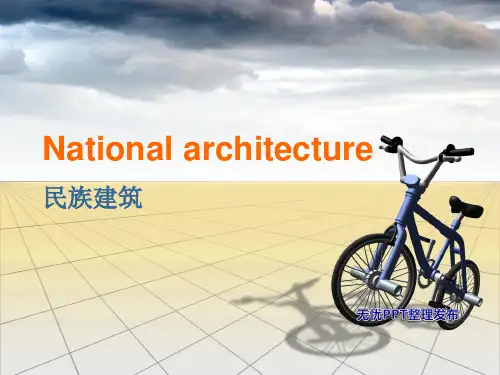
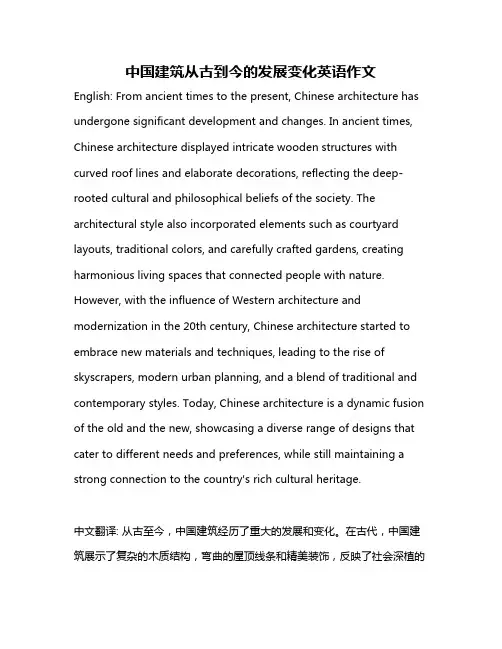
中国建筑从古到今的发展变化英语作文English: From ancient times to the present, Chinese architecture has undergone significant development and changes. In ancient times, Chinese architecture displayed intricate wooden structures with curved roof lines and elaborate decorations, reflecting the deep-rooted cultural and philosophical beliefs of the society. The architectural style also incorporated elements such as courtyard layouts, traditional colors, and carefully crafted gardens, creating harmonious living spaces that connected people with nature. However, with the influence of Western architecture and modernization in the 20th century, Chinese architecture started to embrace new materials and techniques, leading to the rise of skyscrapers, modern urban planning, and a blend of traditional and contemporary styles. Today, Chinese architecture is a dynamic fusion of the old and the new, showcasing a diverse range of designs that cater to different needs and preferences, while still maintaining a strong connection to the country's rich cultural heritage.中文翻译: 从古至今,中国建筑经历了重大的发展和变化。
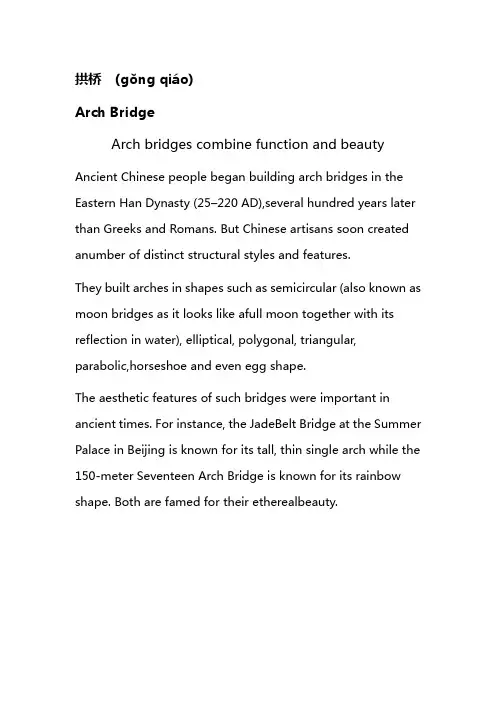
拱桥(gǒng qiáo)Arch BridgeArch bridges combine function and beauty Ancient Chinese people began building arch bridges in the Eastern Han Dynasty (25–220 AD),several hundred years later than Greeks and Romans. But Chinese artisans soon created anumber of distinct structural styles and features.They built arches in shapes such as semicircular (also known as moon bridges as it looks like afull moon together with its reflection in water), elliptical, polygonal, triangular, parabolic,horseshoe and even egg shape.The aesthetic features of such bridges were important in ancient times. For instance, the JadeBelt Bridge at the Summer Palace in Beijing is known for its tall, thin single arch while the 150-meter Seventeen Arch Bridge is known for its rainbow shape. Both are famed for their etherealbeauty.The 150-meter-long Seventeen Arch Bridge at the Summer Palace in BeijingHowever, the best known arch bridge built by ancient Chinese is Zhaozhou Bridge in HebeiProvince. Also known as Anji Bridge or Dashi Bridge, Zhaozhou Bridge is the world's first stoneopen-spandrel segmental arch bridge. It's also the oldest arch bridge in China today.Designed by craftsman Li Chun, the construction of the bridge began in 595 AD and took 11years to complete.The bridge, still used by pedestrians today, is 50.82 meters long, 9.6 meters wide and 7.2 meterstall, with a central span of 37.4 meters. The central arch consists of a curved segment less thanhalf of a semicircle. This clever design allows more water to pass underneath during a flood andits surface isn't as steep,which made it easier for carriages and carts to cross in the old days.Zhaozhou Bridge in Hebei Province is the world's first stone open-spandrel segmental arch bridge.Li also built two smaller arches on each shoulder of the main arch to help further control waterflow during floods. The design had the added benefit of being lighter than most bridges, whichmeant less materials were needed during construction.The bridge is also considered a piece of art because of its well-proportioned layout, elegant structure and beautiful appearance.Lugou Bridge, also called Marco Polo Bridge, is anotherwell-known arch bridge reputed for itsdesign and the incident that sparked China's nationwide War of Resistance Against JapaneseAggression.About 15 kilometers southwest of Beijing, construction of this 213-meter-long, 11-arch granitebridge kicked off in 1189 and it was completed three years later. The bridge features two rows ofcarved white marble balustrades and 501 lion figures in various poses.It was such a beautiful bridge that it won praise from many emperors, poets and writers inancient times.Marco Polo (1254–1324), an Italian merchant and explorer who wrote "Book of the Marvels of theWorld," once described the bridge in his diary."Over this river there is a very fine stone bridge, so fine indeed, that it has very few equals in theworld," he wrote.On July 7, 1937, gun shots were fired near Lugou Bridge, marking the beginning of China'snationwide defensive war against Japan.In 1987, a war memorial hall was built near the bridge andsince then, a ceremony is held everyyear to mark the war's anniversary.Chaotianmen Bridge, which spans the Yangtze River in Chongqing, is another famous archbridge.With a total length of 4,881 meters and a main span of 552 meters, it is now the largest archbridge in the world.The bridge opened in April 2009.One can only wonder what great bridges will be built in China in the future.About 15 kilometers southwest of Beijing, Lugou Bridge is another well-known arch bridge, reputed for itselegant design and the incident that sparked China's nationwide War of Resistance Against JapaneseAggression.Pictorial dictionary·无绞拱(wújiǎo gǒng) fixed archA fixed arch is one of the most common true arch configurations and is widely used in reinforcedconcrete bridges and tunnel construction.Although only suitable for relatively short spans, a fixed arch boasts the most solid structure andleast distortion among all arches. They also cost less to construct and are easy to maintain.Fixed-arch bridges are susceptible to the shifting of abutments, thermal expansion andcontraction, as well as concrete shrinkage, therefore, building bridge abutments on more solidbases is required.Other common arches include two-hinged and three-hinged arches, which are usually used forwider spans. Although they are not as solid as the fixed arch, they require a simpler foundationdesign.。
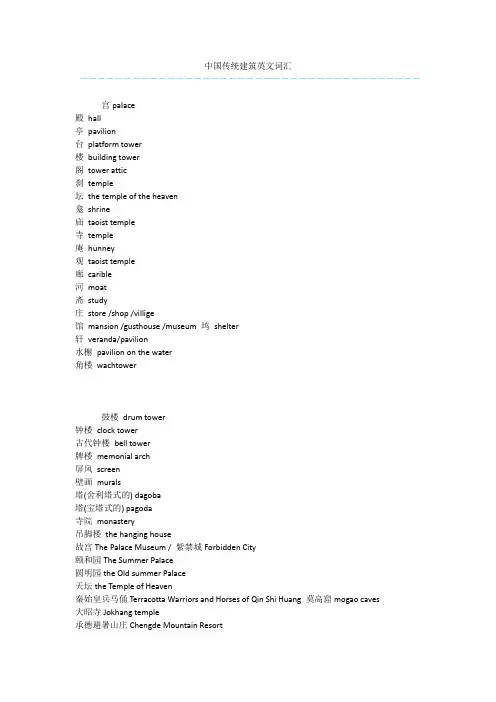
![中国建筑英文介绍[优质ppt]](https://uimg.taocdn.com/8e54f89ed5bbfd0a795673ea.webp)

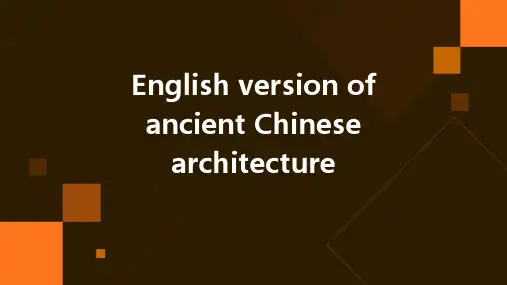
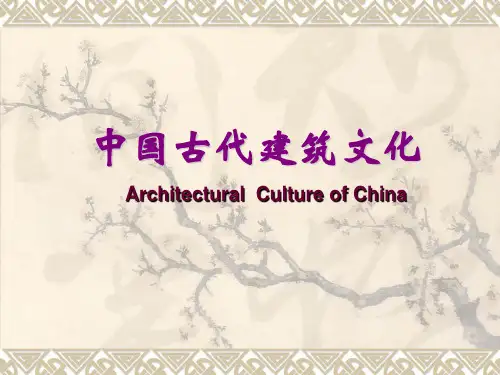
古风建筑英语English:Ancient Chinese architecture, also known as traditional Chinese architecture, is characterized by its unique blend of simplicity, symmetry, and elegance. The design of ancient Chinese buildings often incorporates elements such as wooden structures, curved eaves, and intricate roof tiles. These buildings are typically constructed using traditional techniques and materials like wood, brick, and stone. The layout of ancient Chinese architecture is often centered around the principles of feng shui, with buildings arranged according to their relationship with nature and the elements. Examples of famous ancient Chinese buildings include the Forbidden City in Beijing, the Temple of Heaven, and the Summer Palace.中文翻译:古代中国建筑,也被称为传统中国建筑,以其独特的简约、对称和优雅而闻名。
古代中国建筑的设计通常包括木结构、弯曲的檐口和复杂的屋瓦等元素。
这些建筑通常采用木材、砖瓦和石头等传统技术和材料进行建造。
中国建筑英文视频讲解IntroductionChina’s rich architectural heritage spans thousands of years and reflects the nation’s deep cultural roots. From ancient palaces and temples to modern skyline-defining skyscrapers, Chinese architecture showcases the country’s dedication to innovation and preservation of tradition. In this video, we will explore some of the most famous examples of Chinese architecture and delve into their historical and cultural significance.Traditional Chinese Architecture1. The Forbidden CityThe Forbidden City, located in the heart of Beijing, is a UNESCO World Heritage site and a prime example of traditional Chinese architecture. Built between 1406 and 1420 during the Ming Dynasty, it served as the imperial palace for nearly 500 years. With its iconic red walls and yell ow roof tiles, the Forbidden City’s architecture exemplifies the grandeur and power of Chinese emperors.2. The Great Wall of ChinaNo discussion of Chinese architecture would be complete without mentioning the Great Wall. Spanning over 13,000 miles, the Great Wall is an architectural marvel that stretches across northern China. Built to protect against invasions, the wall showcases the advanced engineering skills of ancient Chinese civilization.3. Temple of HeavenThe Temple of Heaven in Beijing is an exquisite example of ancient Chinese religious architecture. Built in the early 15th century, it was used by emperors from the Ming and Qing dynasties to perform rituals to ensure good harvests. Its circular shape and intricate design symbolize the harmony between heaven and earth.Modern Chinese Architecture1. Shanghai TowerAs one of the tallest buildings in the world, the Shanghai Tower is a modern architectural masterpiece. Completed in 2015, this skyscraper reaches a height of 2,073 feet and features a u nique twisted design. It is a symbol of China’s rapid economic growth and technological advancement.2. CCTV HeadquartersThe CCTV Headquarters in Beijing is an iconic example of contemporary Chinese architecture. Designed by acclaimed architect Rem Koolhaas, this avant-garde building resembles a looped deformed triangle and challenges traditional architectural norms. It serves as the headquarters for China Central Television and has become a symbol of China’s media industry.3. Bird’s Nest StadiumThe Beij ing National Stadium, commonly known as the Bird’s Nest, was the main venue for the 2008 Olympic Games. Designed by Swiss architects Jacques Herzog and Pierre de Meuron, its innovative structure resembles a bird’s nest, hence the nickname. The stadium show cases China’s dedication to pushing the boundaries of architectural design.ConclusionChinese architecture beautifully blends tradition with innovation, showcasing the country’s deep cultural heritage and rapid development. From ancient marvels like the Forbidden City and the Great Wall to modern feats of engineering such as the Shanghai Tower and the Bird’s Nest Stadium, China’s architectural wonders continue to captivate and inspire. By exploring these architectural treasures, we gain a greater understan ding of China’s rich history and its exciting future.。
颐和园(yíhéyuán)Summer PalaceA best preserved imperial parkLocated 15 kilometers to the northwest of Beijing, Yiheyuan or the Summer Palace is the largestand best preserved imperial park in existence in China today.Covering a total area of 293 hectares, it is also considered a museum of the Chinese imperialgardens and architecture.Pavilion of the Buddhist FragranceThe Summer Palace consists mainly of a 60-meter-high hill called Longevity Hill and KunmingLake, which occupies nearly three quarters of the park.Both the lake and the hill are manmade. The hill was built with the earth excavated from diggingthe huge lake, which is a copy of the famous West Lake in the scenic city of Hangzhou in eastChina.The park also boasts a total of more than 3,550 classical, ancient Chinese pieces of architecture,such as palaces, pavilions, towers, waterside halls, platforms, bridges, long galleries andcourtyards.Among them, Pavilion of the Buddhist Fragrance, Long Gallery, Suzhou Market Street, Seventeen-Arch Bridge, the Marble Boat, the Temple of Sea Wisdom and a number of other grand buildingsare best known among both ancient Chinese architecture aficionados and ordinary tourists.Pavilion of the Buddhist Fragrance sits on the middle of the southern slope of Longevity Hill andis the focal point of a cluster of grand buildings dotting the hill. The 41-meter tower featuresthree stories and four levels of flying eaves.The original tower was burned down in 1860 by theAnglo-French Allied Army during the SecondOpium War (1856–1860). The one people see today was rebuilt in 1891 and completed in 1894. Itcost the Qing Dynasty (1644–1911) more than 780,000 taels of silver.The Marble BoatLong Gallery meanders 728 meters at the southern foot of Longevity Hill and along the bank ofKunming Lake. In 1992, it found its way into Guinness World Records as the longestgallery in theworld.The roofed promenade also features more than 14,000 beautiful pictures of landscapes, flowers,birds, historical or legendary figures and popular folk tales painted in bright colors on its beamsand ceilings.Suzhou Market Street is located behind Longevity Hill. Lined with stalls and shops, the street hasall the features of a typical ancient market street in Suzhou, a popular water town about 84kilometers to the west of Shanghai.The 150-meter-long, eight-meter-wide Seventeen-Arch Bridge is a major attraction on KunmingLake. The gracefully designed bridge is often likened to a "white jade ribbon" or a "whiterainbow" flying over the water. Its parapets are adorned with 544 white marble lion sculptureswith distinctive features.The building of this park started in 1750 under the reign of Emperor Qianlong of the QingDynasty. It was then called Qingyiyuan or the Garden of Clear Ripples.It copied some most beautiful gardens in other parts of the country. However, many buildings inthe garden were destroyed during the Anglo-French allied invasion of Beijing during the SecondOpium War.Rebuilding of the park began in 1886 and the project won support from the Empress DowagerCixi (1835–1908), who was widely perceived as an extremely powerful, ruthless and mysteriouswoman who actually controlled the Qing Dynasty for 48 years.To meet her insatiable desire for an extravagant lifestyle and luxuries, Cixi had reportedlyembezzled huge amounts of state funds originally allocated for the Chinese Navy to finance thereconstruction of the imperial park, which was then renamed Yiheyuan or the Summer Palace inEnglish.Later, the empress dowager's embezzlement of the Navy building fund was partly blamed forChina's humiliating defeat in the 1894–1895 Sino-Japanese War.In 1998, the Summer Palace was included by UNESCO on itsWorld Heritage List. It called theimperial park "a masterpiece of Chinese landscape garden design."Today, the Summer Palace is among the top 10 attractions for both Chinese and overseas visitorsin Beijing.The Long Gallery decorated with colorful paintings in the Summer PalacePictorial dictionary·长廊(cháng láng) long galleryAs an integral part of all exquisitely designed Chinese gardens, changlang is a roofed promenadeor covered walkway that connects buildings, ponds, green areas or other functional areas withina plot of land.Changlang is designed mainly to provide people the convenience of moving around in a gardenwhile protected from bad weather.But it also helps to divide a garden into different zones, such as buildings, hills, rockeries, waterareas and green areas.A meandering or zigzag changlang often works as a scheme to create interesting vistas as well asan illusional depth of field in many relatively small gardens.Most such roofed open corridors have their beams and ceilings decorated with colorful paintingsusually featuring landscapes, flowers, birds, historical or legendary figures and scenes from folkstories. So while walking along the corridors, one can have double the enjoyment with bothscenery and art.。
中西方的建筑文化异同举例英语作文英文回答:Architectural Differences Between East and West.The architectural traditions of the East and West have evolved over centuries, each influenced by unique cultural, historical, and environmental factors. While there are some similarities between Eastern and Western architecture, there are also several notable differences that set them apart.1. Form and Function.One of the most fundamental differences between Eastern and Western architecture is the emphasis on form and function. In Western architecture, there is often a clear separation between form and function. Buildings are typically designed to be visually pleasing and imposing, with an emphasis on symmetry, proportion, and order. InEastern architecture, however, form and function are often intertwined. Buildings are designed to be in harmony with their surroundings and to serve a specific purpose. They may be asymmetrical, organic, and less visually impressive than their Western counterparts.2. Materials.The materials used in construction can also vary significantly between Eastern and Western architecture. In the West, buildings are often made of stone, brick, or concrete. These materials are durable and long-lasting, but they can also be expensive and difficult to work with. In the East, buildings are more likely to be made of wood, bamboo, or paper. These materials are more flexible and easier to work with, but they are also more vulnerable to damage.3. Space.The concept of space is another area where Eastern and Western architecture differ. In Western architecture, spaceis often defined by walls and roofs. Buildings aretypically enclosed, with a clear distinction between the interior and exterior. In Eastern architecture, space is more fluid and open. Buildings are often designed with open courtyards and verandas, and there is a greater emphasis on the interaction between indoor and outdoor spaces.4. Decoration.Decoration is another important aspect of architecture that varies between East and West. In Western architecture, decoration is often used to embellish buildings and make them more visually appealing. This decoration can take many forms, from intricate carvings to colorful murals. In Eastern architecture, decoration is more restrained and often serves a symbolic or functional purpose. For example, the use of feng shui in Chinese architecture is intended to ensure that a building brings good luck and prosperity.5. Sustainability.Sustainability is becoming an increasingly importantconsideration in both Eastern and Western architecture. However, there are some differences in the way that the two regions approach this issue. In the West, sustainability is often achieved through the use of modern technologies, such as solar panels and energy-efficient appliances. In the East, sustainability is more often achieved through the use of traditional building techniques and materials, such as passive solar design and natural ventilation.中文回答:东西方建筑文化差异举例。
中西方的建筑文化差异举例英语作文英文回答:Differences between Chinese and Western Architectural Culture.Chinese and Western architectural cultures have evolved over centuries, influenced by diverse geographical, historical, and cultural factors. As a result, they have developed distinct characteristics that reflect the unique values and traditions of each civilization.1. Form and Function.Western architecture has traditionally emphasized form and aesthetics, often prioritizing symmetry, balance, and grandeur. This is evident in iconic structures like the Parthenon in Greece or the Gothic cathedrals in Europe. Chinese architecture, on the other hand, has placed greater importance on functionality and harmony with nature.Buildings were designed to blend with their surroundingsand to serve specific practical needs.2. Materials and Construction Techniques.Western architecture has utilized various materials throughout history, including stone, wood, brick, and glass. These materials have allowed for the creation of towering structures with complex architectural details. Chinese architecture has emphasized timber construction, with elaborate wood-framing systems and tiled roofs. This construction technique has resulted in lightweight and flexible structures that can withstand earthquakes andother natural disasters.3. Symmetry and Asymmetry.Western architecture often employs symmetry and orderin its designs. This is reflected in the regular arrangements of windows, columns, and arches. In contrast, Chinese architecture embraces asymmetry and irregularity. Buildings may feature asymmetrical roofs, uneven walls, andmultiple courtyards. This approach creates a sense of balance and harmony without relying on strict symmetry.4. Openness and Enclosed Spaces.Western architecture has traditionally favored open spaces, with large windows and open-plan layouts. This is exemplified in structures like the glass-walled buildings of modernism. Chinese architecture, on the other hand, has placed more emphasis on enclosed spaces. Courtyards, screens, and partitions create intimate and private areas within larger structures.5. Feng Shui and Geomancy.Chinese architecture is deeply influenced by feng shui, an ancient practice that seeks to create harmony between buildings and their natural surroundings. Buildings are oriented according to the flow of qi (energy) and designed to promote good fortune and well-being. Westernarchitecture does not have a comparable concept, instead relying more on architectural principles like proportion,scale, and color.6. Vernacular Architecture.Western and Chinese vernacular architecture reflect the local traditions and materials of each region. In the West, this includes half-timbered houses in Europe, adobe buildings in the American Southwest, and log cabins in North America. In China, vernacular architecture varies from the traditional courtyard houses of northern China to the stilt houses of the southern coastal regions.中文回答:中西方的建筑文化差异。